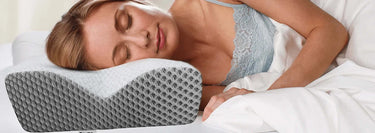How To Choose The Right Leg & Back Support For Everyday Comfort

Leg elevation is more than stacking pillows under your feet. Done with the right support, it can help your body feel lighter, reduce end-of-day tension, and encourage more natural alignment from hip to heel. This guide walks through different types of leg elevation, how high to go, what to watch for with cheaper products, and how to build a simple routine that fits real life.
Why leg elevation matters for daily comfort
Why Structured Leg Elevation Works
Here’s a quick look at how a structured wedge supports your legs from hip to heel and why the setup feels easier on your lower body than improvised elevation.
Most of your day is spent in one of three positions: sitting, standing, or lying down. Each of those can create its own kind of strain. Long workdays, travel, gaming sessions, and even time on the couch can leave your legs and lower back feeling tight or heavy. Leg elevation gives your body a different input. Instead of your legs carrying your weight, they get supported from underneath so your muscles can fully relax.
When your legs are comfortably elevated and supported along their length, your hips can settle into a more neutral position, your lower back can let go of some of its tension, and your overall posture can reset. Think of it as a simple way to give your body a short break from gravity without needing special equipment or a full workout.
The key is structure. A stable, ergonomic surface that supports your legs from calf to heel is very different from a random pile of pillows that collapses or shifts every few minutes. That structure is what turns leg elevation from a quick experiment into a repeatable part of your daily recovery routine.
Everyday situations where leg elevation helps
You do not need a complex protocol to benefit from leg elevation. Most people use it in short, realistic windows that fit their lifestyle. Common examples include:
- After long periods of sitting in an office chair, on a couch, or on an airplane seat.
- After standing for long shifts in retail, hospitality, healthcare, or warehouse work.
- During quiet time in the evening, while reading, streaming content, meditating, or scrolling on your phone.
- On recovery days, when you want to support your legs without a lot of effort or equipment.
- Before sleep, as part of a calming wind-down routine that lets your body feel more settled.
Instead of thinking of leg elevation as a rare event, think of it as another ergonomic tool you can use a few times a week when your legs feel heavy or your lower body feels overworked. The right setup makes it easy to repeat.
Types of leg elevation setups
Not all leg elevation is equal. Some options are improvised and temporary. Others are designed to keep their shape for years. The chart below breaks down the most common setups, how they feel, and what you can realistically expect from each.
| Type of leg elevation | Typical height range | Support consistency | Durability | Typical price range (USD) | Best for | Limitations |
|---|---|---|---|---|---|---|
| Stacked pillows or blankets | 3 - 8 inches | Low, shifts as you move | Low, compresses quickly | Already owned | Occasional use, quick tests | Collapses, uneven height, hard to repeat the same position twice. |
| Inflatable wedges | 6 - 10 inches | Medium at first, less stable over time | Low, air leaks or stretches | 20 - 40 | Travel, temporary setups, infrequent use | Can feel bouncy or noisy, loses firmness, often treated as disposable. |
| Basic foam wedges | 6 - 10 inches | Medium support, single block of foam | Medium, depends on foam quality | 30 - 70 | Short sessions, occasional elevation | Simple geometry, limited ergonomic shaping, support can flatten over time. |
| Ergonomic memory foam wedges | 8 - 12 inches | High, contouring knee curve and calf slope | High, designed to keeps structure for years | 80 - 150+ | Regular use, structured routines, long-term comfort | Higher upfront price but much better long term value. |
Cheaper products and improvised setups usually feel fine for the first few minutes. The issue shows up over weeks and months. Materials compress, air leaks, seams fail, and height becomes unpredictable. That is why many people end up buying multiple low-cost wedges that feel “ordinary and disposable” rather than investing once in a structured, ergonomic design that lasts.

(Above) This graphic compares three leg elevation setups and shows how wedge height affects alignment and overall comfort.
Correct Elevation (Left)
The left panel shows the ideal setup.
The legs follow a smooth elevation arc where the knee curve and calf slope line up naturally with the wedge. The incline evenly supports the legs, the hips stay neutral, and the body settles into a comfortable, grounded position. This is the posture the Rest Ease wedge is designed to create.
Too High (Middle)
The middle panel shows what happens when the legs are raised higher than needed.
The elevation forces the knees and hips into sharper angles, and the body has to work harder to settle. This creates a lifted, unstable posture where the legs feel pushed upward rather than supported by the incline. It shows why matching wedge height to leg length matters.
Too Low (Right)
The right panel shows a wedge that is too low for the user’s proportions.
The incline is not strong enough to create a meaningful elevation arc, so the legs rest almost flat. This reduces the effectiveness of the alignment path and makes the posture feel more like a slight lift rather than a structured elevation.
Price tiers, durability, and real value
Testing Foam High-Quality: Why Cheap Wedges Flatten
This breakdown shows how lower-density foams lose height and structure over time, and why an ergonomic wedge stays consistent even with daily use.
When you look at leg elevation by price alone, it is easy to assume all wedges are basically the same. They are not. The material quality, shape, and density profile make a bigger difference than any logo printed on the side.
| Price tier | Example products | Expected lifespan | Comfort profile | Typical experience over time |
|---|---|---|---|---|
| Under 40 | Inflatable wedges, thin foam blocks | Months of regular use | Support feels uneven, height can vary | Often treated as ordinary and disposable. Many people replace them repeatedly as they lose shape. |
| 40 - 80 | Basic foam wedges from big box retailers | Several months to a couple of years | More stable than inflatable designs, with limited ergonomic shaping | Better than improvised options but can still compress, especially under daily use. |
| 80 - 150+ | Ergonomic memory foam wedges like Rest Ease™ | Designed for years of structured use | Consistent support with a smooth knee curve, calf slope, and heel support | Feels more like a piece of long term equipment than a throwaway pillow. Shape and height stay predictable so your routine stays consistent. |
If you add up the cost of several inexpensive wedges that flatten or lose their shape, a durable ergonomic wedge is the cheaper option over time. The real savings come from stability. When your setup feels the same every night, your body learns the position and relaxes more quickly.

(Above) This diagram compares how a structured incline from a leg-elevation wedge behaves with a soft pillow.
Structured Incline (Left)
The left side shows the engineered shape of the wedge supporting the legs along a smooth, predictable elevation path.
The knee curve, ramp angle, and calf slope work together to guide weight into a stable position. This creates a consistent alignment where the legs settle calmly instead of shifting or sinking.
Soft Pillow (Right)
The right side shows what happens when a pillow is used for elevation.
Because the pillow compresses unevenly, the legs sink into the surface and the angles change unpredictably. The elevation arc becomes shallow and unstable, and the knees and lower legs fold in ways the user can’t control.
What the Comparison Shows
The graphic highlights why wedge geometry matters.
A structured incline preserves the angles the body needs for a steady, grounded position. At the same time, a soft pillow collapses under load and loses the alignment the user is trying to achieve.

How high to elevate your legs
Correct Height for Leg Elevation
This short clip gives a simple reference for heel height and the angle most people find comfortable in daily use.
There is no single perfect height that works for every person. Your height, preferred sleep position, mattress, and flexibility all matter. For most adults, a range of roughly 8 to 12 inches of elevation at the heel feels comfortable and sustainable.
Instead of chasing a specific number, focus on three checkpoints:
- Your knees feel relaxed with no sharp angle or pinching at the back of the leg.
- Your lower back feels supported rather than arched or pushed too flat.
- You can stay in position for at least 15 to 20 minutes without wanting to constantly adjust.
Elevation Duration Guide for Everyday Use

(Above) This diagram shows how different session lengths feel when using the Rest Ease wedge. The arc represents a gradual progression from short sessions to longer routines.
Short (10–15 minutes)
A quick reset that lets the legs settle into the incline without committing to a full session. Ideal for a mid-day break or after sitting for long stretches.
Medium (20–30 minutes)
A balanced session in which the body has more time to relax into the knee curve and the calf slope. This is a comfortable window for reading or winding down in the evening.
Long (45+ minutes)
A deeper, unhurried session where the legs follow the whole elevation arc and stay supported by the structured incline. This is common during longer relaxation periods or when you want a steady, grounded posture after a long day.
The color bands visually reinforce how session length scales naturally, helping users understand that elevation can be flexible and easy to fit into daily routines.
Many people start on the lower end of the height range and gradually work up once their body is used to the new position. With a structured wedge, you get the same height every time, which makes it much easier to notice how your body responds over days and weeks.
Why ergonomic design matters more than height alone
Height is only one part of the equation. Two wedges can have the same height but feel entirely different. The surface shape, transitions, and foam density all change how your legs and hips experience support.
A well-designed ergonomic wedge usually includes:
- A smooth knee curve that cradles the legs instead of cutting into them.
- A gentle calf slope that supports the full length of your lower leg.
- A stable heel platform so your heels are not hanging in mid air or digging into a hard edge.
- Multi layer foam construction where the base provides structure and the upper layer provides comfort.
This kind of shaping encourages better alignment from hip to heel, which can help reduce daily tension and stiffness. If you want a deeper look at how Zen Bloks approaches ergonomic shaping, you can explore the Zen Bloks ergonomic design overview.
Where the Rest Ease™ leg wedge fits in
Rest Ease™ Wedge Build & Structural Support Overview
This overview breaks down the shaping, contours, and foam build that give the Rest Ease™ wedge its long-term stability and consistent support.
The Rest Ease™ Leg Elevation Wedge was built for people who want a structured, repeatable leg elevation setup that actually lasts. Instead of a single block of foam, it uses a carefully chosen density profile to keep its shape session after session.
The ergonomic knee curve, calf slope, and upper leg incline work together to encourage a natural position from hip to heel. That structure makes it easier to:
- Let your lower body fully relax after sitting, standing, or training.
- Support your legs in a way that feels balanced rather than rigid.
- Build a realistic nightly routine that you can repeat without constantly adjusting pillows.
Rest Ease™ is designed as long term equipment, not an ordinary disposable wedge. The goal is to give you a consistent, reliable surface that you can integrate into your evenings for years, not months.
How to use a leg elevation wedge step by step
How to Position Your Legs on a Wedge
A quick visual showing where your knees, calves, and heels should rest on the wedge so the incline feels natural and consistent.
Once your wedge is set up, using it is simple. The key is consistency. Small sessions that you repeat are far more valuable than rare marathon sessions.
- Set up your space. Place the wedge near the foot of your bed, on a sofa, or on a mat where you can lie back comfortably with your head supported.
- Position the wedge under your legs. Your knees should rest near the highest point of the wedge, with your calves and heels fully supported along the slope.
- Check for full contact. Your thighs, calves, and heels should all feel contact with the wedge. If you feel a gap, adjust your position slightly.
- Start with shorter sessions. Begin with 10 to 15 minutes while reading, streaming, or listening to music. Let your body get used to the position.
- Build a routine. A common pattern is one session after work and another before sleep. Over time, this can become a simple signal to your body that it is time to relax.
- Pair it with mindful breathing. Slow breathing can help your muscles release lingering tension and make the position feel even more restorative.
Many people find that leg elevation pairs well with an ergonomic seat cushion during the day. You support your posture while sitting, then give your legs structured support in the evening. If you spend long hours sitting, you can explore the Zen Bloks XL Gel Seat Cushion as a complement to your leg wedge.
Care, cleaning, and longevity
Taking basic care of your wedge can extend its life and keep it feeling fresh. A high density memory foam wedge is built to last, but covers and surfaces still benefit from simple maintenance.
- Use the washable cover. Keep the foam protected. Wash the cover as needed according to the care label.
- Give it time to recover. After each session, let the wedge rest flat so the foam can return to its original shape.
- Avoid sharp bending or folding. Constant folding can stress seams and edges over time.
- Store in a dry, cool area. Extreme heat can affect foam performance. Keep it away from heaters or direct sun for long periods.
With basic care, a quality ergonomic wedge can remain part of your nightly routine for years, which is why it is worth choosing one that is built to keep its structure instead of one that feels disposable.
Frequently asked questions about leg elevation
How often should I elevate my legs?
Many people start with 10 to 20 minutes a few times per week and adjust based on how they feel. Some prefer a short session after work, others like a longer session before sleep. The most important factor is consistency rather than intensity.
Can I sleep all night on a leg wedge?
Some people enjoy sleeping with their legs elevated, others prefer it only for shorter sessions. If you test overnight use, pay attention to how your hips, lower back, and knees feel in the morning. If your body feels stiff, you may want to limit elevation to wind-down sessions instead.
Should my feet hang over the edge?
In most cases your heels should be supported on the wedge surface so there is no sharp edge pressing into your legs. A smooth transition at the heel usually feels more natural and easier on your body over time.
Do I need a leg wedge if I already use an ergonomic seat cushion?
A seat cushion helps support posture while you sit. A leg wedge helps your lower body reset when you lie down. Many people find that using both gives them a more complete approach to daily comfort, especially if they spend long hours at a desk.





